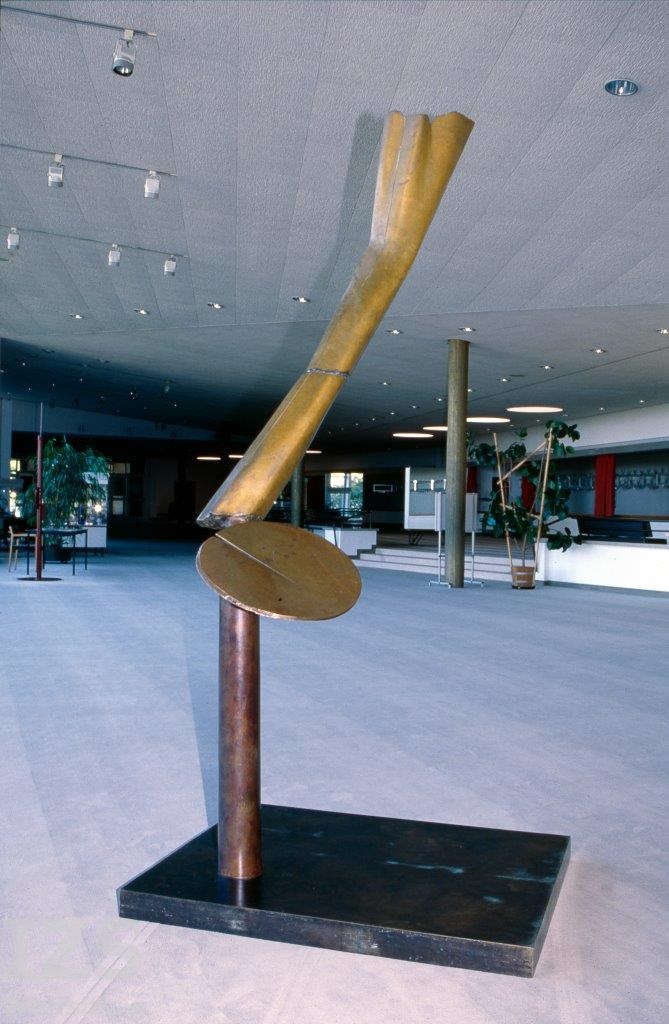Seraph 2000, Bernhard Heiliger (1972)
From Maik Ullmann
"The theatrical experience here must begin before the performance", -__-0000-__- states the competition program for the construction of a playhouse on Wolfsburg's Klieversberg with reference to the entrance hall of the theater to be planned. It was not only the stage or the auditorium that was to become a place of experience for visitors to the theater. Rather, the entrance to the building should be experienced as an autonomous space as soon as you enter. The seven expert judges, led by architect and urban planner Werner Düttmann from Berlin and architect Werner Kallmorgen from Hamburg, received extensive submissions from seven architects and architectural teams from Finland, Denmark and Germany, which included models, sections and floor plans, as well as designs for the exterior and interior of the theater building. In addition to the Wolfsburg architects Titus Taeschner and Richard Rudolf Gerdes, Alvar Aalto, known in Wolfsburg for his cultural center, also submitted a design. In the end, however, the Berlin architect Hans Scharoun prevailed. Neither these architects nor Jørn Utzorn, famous for his Sydney Opera House, or Friedrich Spengelin, known among other things for his new church interior of the Hamburg Holy Trinity Church, were able to convince the jury with their competition entries. The same applied to Fritz Bornemann, architect of the Deutsche Oper zu Berlin, as well as the team of Gerd Pempelfort and Jost Schramm from Hamburg, whose signatures can be seen on numerous buildings there.
Scharoun received the commission in the spring of 1966, but the magazine Bauen Wohnen criticized the somewhat "opulent" front zone of the theater space, -__-0001-__- which was attractive for visitors but problematic for theatrical groups. However, the author of the report fails to provide an explanation for this. However, early sketches indicate that a generally generous spatial design, especially for the foyer, was planned from the outset and that this effect was also conceived by Scharoun - nothing less than a "spatial experience" was to be created.-__-0002-__- A surviving correspondence between the Berlin sculptor Bernhard Heiliger and Wolfsburg city councillor Karl-Heinz Schulte from 1984 confirms this assumption. It shows that Scharoun was planning to design the foyer with an abstract work by Heiliger at the time: "He saw this sculpture -__-0003-__- at my place and spontaneously thought it was particularly suitable for the large hall." -__-0004-__- (Fig. 1) The bronze sculpture in question measures 2.50 meters in height; it bears the epithet vegetative sculpture. The three-part figure is attached to the edge of a black rectangular block of stone. Starting from a pipe, the middle part of the sculpture evokes associations with a plant due to the indicated leaf stalk. The upper part - Heiliger has detached himself from the geometric form here - resembles a plant stem limb and ends in a stylized flower bud. But as suitable as the artist saw his sculpture for the Wolfsburg theater building - when it was opened, the sculpture entitled Seraph 2000 was not yet in its current location.

After Scharoun's death in November 1972, Heiliger was asked to advocate the installation of his bronze sculpture as a loan in the Wolfsburg theater in accordance with the architect's wishes - and thus sparked a lengthy decision-making discussion in the city administration. -__-0000-__- This was probably also complicated by the fact that he initially attempted to sell his sculpture to the city at a price of 155,000 DM. The administration, on the other hand, had assumed a longer-term loan and had not earmarked any funds for a purchase. -__-0001-__-
The Seraph 2000, which was inspired by a mythical angelic creature from the books of the Old Testament, was conceived as a "sculptural counterpart" to Scharoun's theater building. -__-0002-__- In consultation with the architect's widow, the artist finally granted the city a right of first refusal due to the special circumstances, as several potential buyers had apparently already expressed an interest in the figure. -__-0003-__- Head of Cultural Affairs Karl-Heinz Schulte was to put the sculptor's patience to the test. -__-0004-__-
There was no internal consensus on whether Seraph 2000 should be purchased or not. A telephone memo from city councillor Volkmar Köhler for Schulte illustrates the situation within the administration: the head of the city council, Werner Hasselbring, was "of the opinion that it -__-0005-__- is really out of the question at the moment. He will support it if we try to postpone the matter." Heiliger never tired of emphasizing that the sculpture had been placed in the theater at Scharoun's explicit request. In the meantime, he insisted that the purchase should be completed as "planned": "It would be more than welcome if, after all these years, this process could finally be 'normalized' in the way originally planned." -__-0006-__- No reply from the city administration has survived, but an excerpt from the minutes of the meeting of the department heads on November 16, 1976, reveals that the city was now prepared to enter into negotiations with the artist for a purchase price of 80,000 DM.-__-0007-__-
This decision was preceded by a discussion in the art advisory council. The participants agreed that Heiliger's work had become part of Wolfsburg's cityscape (Fig. 2).-__-0008-__- Despite slight reservations about the sculpture - "-__-0009-__- a typical Heiliger -__-0010-__- would have been better"-__-0011-__- - Volkmar Köhler questioned whether the architect had intended the sculpture to be less conspicuous. Despite a reduction of almost 50 percent in the price originally quoted by Heiliger, he relented. According to the artist, the price was hardly appropriate, but "on the other hand, it would be a shame if Wolfsburg were unable to acquire the 'Seraph 2000'".-__-0012-__- The decisive factor in finalizing the purchase was Volkmar Köhler's visit to the Berlin sculptor's studio in the spring of 1977, which he described to city councillor Schulte in a letter as follows:
"During the visit tohis studio, I came to the conclusion that the sculpture standing in the Stadttheater is absolutely typical of the phase of his work that has already been going on for several years. In terms of quality, the work occupies a good position in this phase and, at DM 80,000, must be regarded as unusually reasonably priced."-__-0013-__-

Placing another of Heiliger's sculptures in the place of Seraph 2000 was not an option because
"-__-0000-__-according to Heiliger, the harmonious relationship of the sculpture as a complementary, vertical accent to the architecture is fully intended by him and corresponds to Scharoun's intentions. On the other hand, a strongly dominant, different work would break this harmony and act as an exhibition in the foyer."
Heiliger's patience and absolute determination to comply with the late architect's wishes paid off in the end. After Schulte, head of the cultural department, had received the declaration of consent from all members of the art advisory board, -__-0001-__- the culture, finance and administration committees had given their approval for the purchase of the sculpture, -__-0002-__- the sculptor received notification of the purchase decision in June 1977. -__-0003-__- The sculpture Seraph 2000 still adorns the entrance area of the Wolfsburg Theater today. In the spirit of its creator, the object forms a unity with Scharoun's building, which the theater audience can no longer separate.
Sources
-__-0000-__- Bauen Wohnen, Vol. 21 (1966), No. 6, Competitions section, n.p.
-__-0001-__- Ibid.
-__-0002-__- J. Christoph Bürkle, Hans Scharoun und die Moderne. Ideas, projects, theater construction. Frankfurt am Main 1986, p. 184; Forum Architektur der Stadt Wolfsburg, Hans Scharouns Theater für Wolfsburg 1973-2013. Berlin 2013, p. 45, quote p. 150.
-__-0003-__- IZS Wolfsburg, Az. 47 52 20, Kunst im Stadtbild, Künstler 'H', Heiliger an Schulte vom
December 5, 1984.
-__-0004-__- IZS Wolfsburg, Kunst im Stadtbild, Künstler 'H', excerpt from the minutes of the 7th meeting of the Culture Committee on September 7, 1973.
-__-0005-__- IZS Wolfsburg, Kunst im Stadtbild, Künstler 'H', excerpt from the minutes of the 14th meeting of the Culture Committee on May 3, 1974.
-__-0006-__- IZS Wolfsburg, Kunst im Stadtbild, artist 'H', Heiliger to Schulte dated April 20, 1974.
-__-0007-__- Ibid.
-__-0008-__- IZS Wolfsburg, Kunst im Stadtbild, artist 'H', Schulte to Heiliger, May 2, 1974.
-__-0009-__- IZS Wolfsburg, Kunst im Stadtbild, artist 'H', Heiliger to Kern dated August 10, 1976.
-__-0010-__- IZS Wolfsburg, Kunst im Stadtbild, artist 'H', excerpt from the minutes of the 31st departmental meeting of November 16, 1976; ibid., Schulte to Heiliger of November 19, 1976.
-__-0011-__- Here and in the following IZS Wolfsburg, Kunst im Stadtbild, preliminary excerpt from the minutes of the Art Advisory Board meeting of August 12, 1976.
-__-0012-__- Ibid.
-__-0013-__- IZS Wolfsburg, Kunst im Stadtbild, artist 'H', Heiliger to Schulte of November 29, 1976.
-__-0014-__- IZS Wolfsburg, Kunst im Stadtbild, Köhler to Schulte dated March 8, 1977.
-__-0015-__- IZS Wolfsburg, Kunst im Stadtbild, Schulte to Gustav Kurt Beck, Bert Bilzer, Werner Grohn, Jürgen Schweitzer, March 16, 1977; ibid., Bilzer to Schulte, March 24, 1977; ibid., Grohn to Schulte, March 25, 1977; ibid., telephone note Gustav Kurt Beck, April 13, 1977.
-__-0016-__- IZS Wolfsburg, Kunst im Stadtbild, excerpt from the minutes of the 6th meeting of the Culture Committee on June 1, 1977; ibid., excerpt from the minutes of the 13th meeting of the Finance Committee on June 9, 1977.
-__-0017-__- IZS Wolfsburg, Kunst im Stadtbild, Schulte to Heiliger, June 20, 1977.
